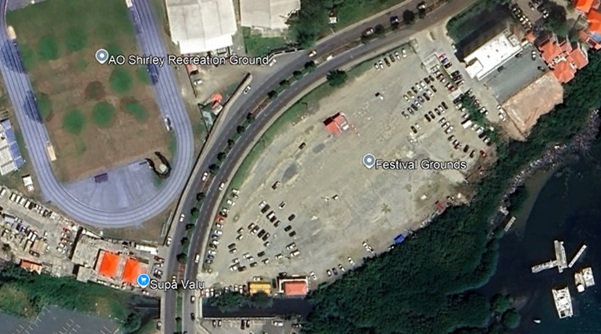INVITATION TO TENDER FOR THE INSTALLATION OF AN ELECTRIC VEHICLE CHARGING STATION

SCOPE OF WORKS
This document outlines the scope of work for the turnkey delivery of a ten-bay electric-vehicle charging facility consisting of five (5) direct current fast chargers (DCFC) rated 120 kW each, one of which is Tesla-capable (SAE J3400 + CCS Type 1), together with a pad-mounted transformer, 480Y/277V distribution, site lighting, a freestanding canopy with integrated drainage, and a grid-tied solar photovoltaic (PV) system.
LOCATION
The location of the proposed charging station is in Road Town at the festival ground:

Figure 1: Proposed location of the EVC.
OUTLINE SCOPE OF WORKS
This Scope of Works (SoW) outlines the requirements and specification for the turnkey delivery of a 10-bay charging station with 5 dual-port DC fast-charging (DCFC) facility including the associated electrical substation and integrated solar PV. This will include all works associated with the design, construction and commissioning of the facility. A high level scope is below:
- EV Charging System: Five (5) 120kW direct current fast chargers (each dynamically sharing 2 × 60kW), cable management, bollards, signage, and accessibility features.
- Power Distribution: Medium-voltage to low-voltage transformation, 480Y/277V switchboard, feeders, earthing, surge protection, and metering.
- Lighting: 120/208V lighting luminaires, poles, and controls provided by separate low power transformer.
- Canopy: Freestanding steel canopy with integrated, concealed drainage and concealed service routes.
- Civil & Structural Works: Foundations, plinths, pavements, grading, drainage, trenching, reinstatement, and hurricane-region wind design.
- Solar Photovoltaic (PV): Canopy-mounted PV array with a SolarEdge 80kW alternating current inverter interconnection at 480V, monitoring, and utility interconnection.
- Communications & Software: Backhaul, router/firewall, Open Charge Point Protocol (OCPP) connection to the employer’s charge-station management system, and payment systems.
- Testing, Commissioning, and Operations & Maintenance: End-to-end commissioning, training, documentation, and warranty/service.
STANDARDS
The following standards should be used as guidance for the design and construction of the facility.
- Electrical: National Electrical Code (NEC; NFPA 70), including Article 625 (EV Charging) and Article 690 (PV); IEEE/ANSI C57 (transformers); UL/CSA listings appropriate to equipment.
- Accessibility & Layout Best Practice: PAS 1899 (Accessible EV Charging) for user space, reach, and impact-protection clearances.
- Wiring best practice (advisory): BS 7671 and IET guidance (for reference where helpful).
- Payments & Cybersecurity: Payment Card Industry Data Security Standard (PCI-DSS); Transport Layer Security (TLS)-secured communications; OCPP 2.0.1 (minimum 1.6 JSON).
- Utility: BVI Electricity Corporation (BVIEC) interconnection and metering requirements.
- Permits and approvals: The contractor shall obtain all approvals required by the Electrical Inspection Unit and BVIEC and shall coordinate any civil permits/road openings.
DOCUMENT PRIORITY
The hierarchy of priority for project documentation is as follows:
- Statutory Regulations
- Standards
- Design Drawings
- Specifications
- Good Practice Guides
SYSTEM DESCRIPTION
The facility will be capable of charging 10 cars at a rate of 60kW each concurrently. It will have the following characteristics:
- Five (5) direct current fast chargers, each 120kW total (two outputs sharing 2 × 60kW). One charger Tesla-capable (SAE J3400 + CCS Type 1); four chargers dual CCS Type 1.
- The supply voltage will be 480Y/277V, three-phase, 60Hz distribution from a pad-mounted transformer.
- The Main switchboard will be a 1,200A bus with 1,000A main breaker (ground-fault protection of equipment) with appropriate surge protection and metering.
- A hot dipped galvanized steel canopy with integrated, concealed gutters and downpipes within columns, fascia/flashings and concealed service routes. The canopy will have integrated lighting at 120/208V providing a limited space around the charging facility.
- A Solar PV system will for the roof of the canopy. The PV array will consist of 186 modules (1950 x 1134 x 30mm) providing a 93kWp array.
SPECIFICATION
Direct Current Fast Chargers
- Power and sharing: 120kW per unit, dynamically shared across two outputs (2 × 60kW).
- Input power: 480 V three-phase, 60Hz, three phase conductors plus equipment grounding conductor (no neutral); maximum input current ≈ 153A per unit.
- Overcurrent protection: 200A, three-pole feeder breaker per unit; feeders sized for continuous load at not less than 125 percent, subject to derating.
Connectors:
- Charger 1: SAE J3400 (North American Charging Standard) + CCS Type 1.
- Charger 2 – 5: Dual CCS Type 1.
- Cables: Not less than 5.4m (18ft) with management.
- Environmental: Outdoor-rated (e.g., NEMA 3R/4 or IP54/55), marine-grade coatings, 316 stainless-steel fixings.
- Software and networking: OCPP 2.0.1 (minimum 1.6 JSON), remote firmware, diagnostics, site load management; integrate to [Employer’s CSMS name].
- Payments: EMV contactless and chip, RFID, and app/QR; PCI-DSS compliant.
- Accessibility: User interface and holsters approximately 900–1,200mm above finished surface; maintain 1,200mm clear operating strip in front.
Transformer (Medium Voltage to 480Y/277 V)
- Type: Three-phase, pad-mounted, liquid-immersed, tamper-resistant, dead-front.
- Rating: 1,000kVA ONAN.
- Primary: Match BVIEC feeder (e.g., ~13.2kV class); loop-feed terminations; surge arresters; no-load tap changer ±5 percent (±2 × 2.5 percent). To be confirmed with BVIEC.
- Secondary: 480Y/277V, solidly grounded neutral; typical impedance about 5.75 percent; low-voltage pads sized for parallel conductors.
- Accessories: Pressure-relief device, gauges, drain/sampler, wildlife guards; marine-duty coating; natural-ester fluid preferred.
Main Switchboard and Distribution (480Y/277 V)
- Bus and main: 1,200A bus; 1,000A three-pole main breaker with ground-fault protection of equipment; utility metering as required.
- Short-circuit current rating: Not less than 35kA at 480V (or as shown by the fault study).
- Surge protection: Type 1/Type 2 surge protective device at service.
- Charger feeders: Five (5) 200A three-pole breakers; circuits are three phase conductors plus equipment grounding conductor (no neutral); voltage drop not more than 3 percent to each charger.
- Sub-Panel: One 25A three-pole feeder to a 277/480V sub panel for monitoring and auxiliary power.
Lighting
- Luminaires: LED area lighting suitable for coastal exterior use; drivers rated 120V).
- Controls: Photocell and PIR; local override at the service area; lighting levels to a minimum of 25 uniformly distributed across the facility.
Canopy with Integrated Drainage and Concealed Services
- Structure and finish: Freestanding steel canopy, hot-dip galvanized with coastal duplex paint; 316 stainless-steel fixings; minimum clear height 2.5m; roof pitch approximately 5–10 degrees; full fascia and end flashings to conceal purlins and cableways.
- Drainage: Continuous perimeter gutter sized to rainfall (baseline 150 mm half-round with 75 mm downpipe or hydraulic equivalent); conceal downpipes inside columns with clean-outs at base; provide emergency overflow scuppers discharging away from charger operating zones; no drip into the 1,200 mm operating strip.
- Services: Concealed cableways within beams or behind fascia; 25 percent spare capacity with removable access panels.
- Lighting integration: 120V luminaires integrated to the canopy soffit/beam; marine-rated components.
- Structural and earthing: Foundations designed to geotechnical recommendations and hurricane-region wind criteria; account for water-filled gutters and downpipe thrust; bond canopy steel, gutters, and downpipes to the site earthing grid.
Civil and Structural Works
- Surveys and geotechnical: Topographic and utility surveys; geotechnical investigation and report.
- Grading and stormwater: Grading plan with finished spot levels, crossfalls, and tie-ins; stormwater sizing and calculations; overflow routing that avoids charger operating areas.
- Pavements: Parking bays 100mm concrete; drive aisles 125–150mm; contraction joints at 24–30 × thickness (maximum ~4.5m panels); surface falls not more than 1:50.
- Foundations: Canopy footings, transformer and switchboard pads, lighting pole bases, charger plinths (≥150mm thick), and bollard footings; anchor-bolt templates and grout pads.
- Trenching and ducting: Depths, bedding, warning tape, and backfill per drawings; rigid galvanized steel risers where exposed; minimum burial cover 1,000mm unless agreed by the Electrical Inspection Unit; reinstatement to equal or better condition.
- Accessibility: At least one accessible charging bay with compliant slopes and dropped kerb within approximately 8–20m; markings and signage.
Solar Photovoltaic (PV) System
- Design intent: Grid-tied canopy-mounted PV to offset site energy.
- Target alternating-current rating: SolarEdge 80kW at 480V three-phase inverter.
- Target direct-current rating: 93kWp solar array consisting of 186 PV modules (glass-glass, bifacial) suitable and tested for a sandy and corrosive environment.
- Codes and interconnection: NEC Article 690 including rapid shutdown for structure-mounted PV; inverter(s) certified UL 1741 SB with IEEE 1547-2018 functions; obtain BVIEC interconnection approval and provide final protection settings.
- Equipment: Tier-1 modules (450–600W class or better), salt-mist certified; racking suitable for coastal exposure; string combiners or module-level power electronics as required; visible, lockable PV alternating-current disconnect adjacent to the switchboard; revenue-grade production meter with current transformers; monitoring portal with five-minute interval data export.
- Direct-current wiring: PV-rated cable, UV-resistant, in metallic raceway where exposed; direct-current surge protective devices at array/combiner and inverter inputs; continuous equipment bonding.
- Alternating-current interconnection: 125A three-pole back-fed breaker with hold-down device on the 480V switchboard; locate the breaker to comply with the 120-percent busbar rule or the approved study; provide a Type 2 AC surge protective device at the PV output section.
- Integration with canopy: Route PV cabling in concealed cableways; maintain drainage performance; no overflow onto charger operating zones.
Cabling, Containment, Earthing, and Labelling
- Conductors (typical to chargers): 2/0 AWG copper THHN/THWN-2 (or 250kcmil aluminium XHHW-2) plus equipment grounding conductor, sized per code and derating; design for not more than 3 percent voltage drop.
- Raceways and containment: Underground PVC schedule 40/80; rigid galvanized steel for risers/exposed; polymer-concrete handholes with bolt-down lids labelled “EV POWER”; one spare conduit to each charger; warning tape 300 mm above runs.
- Earthing and bonding: Main bonding jumper at service; bond pads, canopy steel, gutters, downpipes, bollards (if metallic), and handholes as detailed.
- Labelling: NEC, utility, and PV placards; arc-flash and device settings labels; charger identification and signage (“EV CHARGING ONLY” and bay numbers).
SCOPE OF WORK
The contractor shall undertake the following tasks:
Pre-Mobilisation
- Designs: The following designs will need to be submitted to the authority for approval:
- System layout
- Single-line diagram
- Panel schedules
- Conduit and cable schedules
- Charger mounting and plinth details
- Canopy framing and drainage
- Pavement/jointing plan
- Lighting calculations
- PV layout and stringing
- Construction Plan: Provide a project plan including the named individuals responsible for works and health and safety.
- Health and Safety: Site-specific health and safety plan, including lifting plan, site access plan.
- High-risk risk assessments and method statements: Detailed method statements for all electrical works, working at height, canopy erection, lifting, and hot works.
Mobilise
Establish site compound, welfare, storage, and laydown. Conduct site familiarisation and confirm access routes and working hours with the employer [insert hours/constraints].
Civil and Structural Works
Survey set-out; trenching and ducting; foundations and pads; pavements and reinstatement; canopy erection (including drainage water test); lighting pole bases and erection.
Electrical Installation
Set transformer; install switchboard, surge protective device, metering, and lighting panel board; pull and terminate feeders; install chargers and local disconnects (if required); lighting and controls; communications cabinet, router, antennas; PV arrays, inverters, disconnects, metering, and monitoring.
Testing, Commissioning, and Training
- Electrical tests: Insulation resistance, continuity, torque verification, phasing and polarity checks; settings and functional checks for ground-fault protection of equipment and other protective devices.
- Chargers: Start/stop, payment flows, network connectivity and failover, remote control, load sharing, emergency stop, and safe restart after power failure; demonstrate simultaneous charging on two ports; demonstrate charging of a Tesla vehicle via SAE J3400 and a CCS Type 1 vehicle on the Tesla-capable unit.
- Lighting: Photocell/timeclock/contactor functions and night aiming as required.
- Photovoltaic system: Rapid-shutdown demonstration; inverter start-up and monitoring; performance demonstration to at least 95 percent of expected power under defined irradiance and temperature conditions (with standard correction if conditions differ).
- Training: Training of employer’s staff; handover documentation.
Handover Documentation
The contractor will be expected to provide the following documentation at handover:
- Operation & Maintenance (O&M) Manual: This will include manufacturer specifications, maintenance procedures, and troubleshooting guidance for all equipment installed.
- Asset Register: This is to include all assets installed as part of the system.
- Health & Safety File: This should be produced in accordance with the recommendations of the HSE and include as a minimum risk assessment, method statements, and any incident reports.
- Commissioning Report: This will need to include the testing methodology, equipment calibration certification and test results.
- As-Built Drawings: Drawings and system schematics (for example: electrical & PID) reflecting final installation details. This should include all necessary information needed for recording on the asset register such as serial numbers.
- Warranty: All warranty and product certification for installed equipment and components.
SITE VISIT
The opportunity to visit the site will be made available to all bidders. Arrangement should be through the point of contact at the bottom of this RFP.
RESPONSE
Respondents are to provide all information in PDF format. No website links are to be provided and will not be followed. Respondents are required to provide a priced quote with the following information:
- System Design containing the following information:
- Canopy design and layout.
- Data sheets for the following equipment:
- Chargers
- Transformer
- Solar PV Modules
- Inverters
- Electricity Meter
- Mounting System
- An outline project plan.
- Warranty Information for all major equipment, including a 2-year warranty on installation works and workmanship.
INFORMATION
The information and designs contained within this pack are for information and all bidders are expected to conduct their own site assessments, designs and calculations to meet this specification.
SUBMISSION DEADLINE
November 28th, 2025.
POINT OF CONTACT
The point of contact for any clarifications will be:
General Manager
British Virgin Islands Electricity Corporation
PO BOX 268
Road Town, Tortola, VG1110
Virgin Islands
Email: bviecgm@bvielectricity.com
The Invitation to Tender Document Can Be Downloaded Below:
Invitation to Tender for the Installation of an Electric Vehicle Charging Station
Archive
- November 2025
- October 2025
- September 2025
- August 2025
- July 2025
- June 2025
- May 2025
- April 2025
- March 2025
- January 2025
- December 2024
- July 2024
- February 2024
- June 2023
- December 2022
- August 2022
- January 2022
- November 2021
- October 2021
- May 2021
- January 2021
- December 2020
- June 2020
- March 2020
- October 2019
- August 2019
- November 2018
- July 2018
- August 2017
- May 2017
- January 2017
- October 2016
- September 2016
- August 2016
- March 2015
- December 2014


